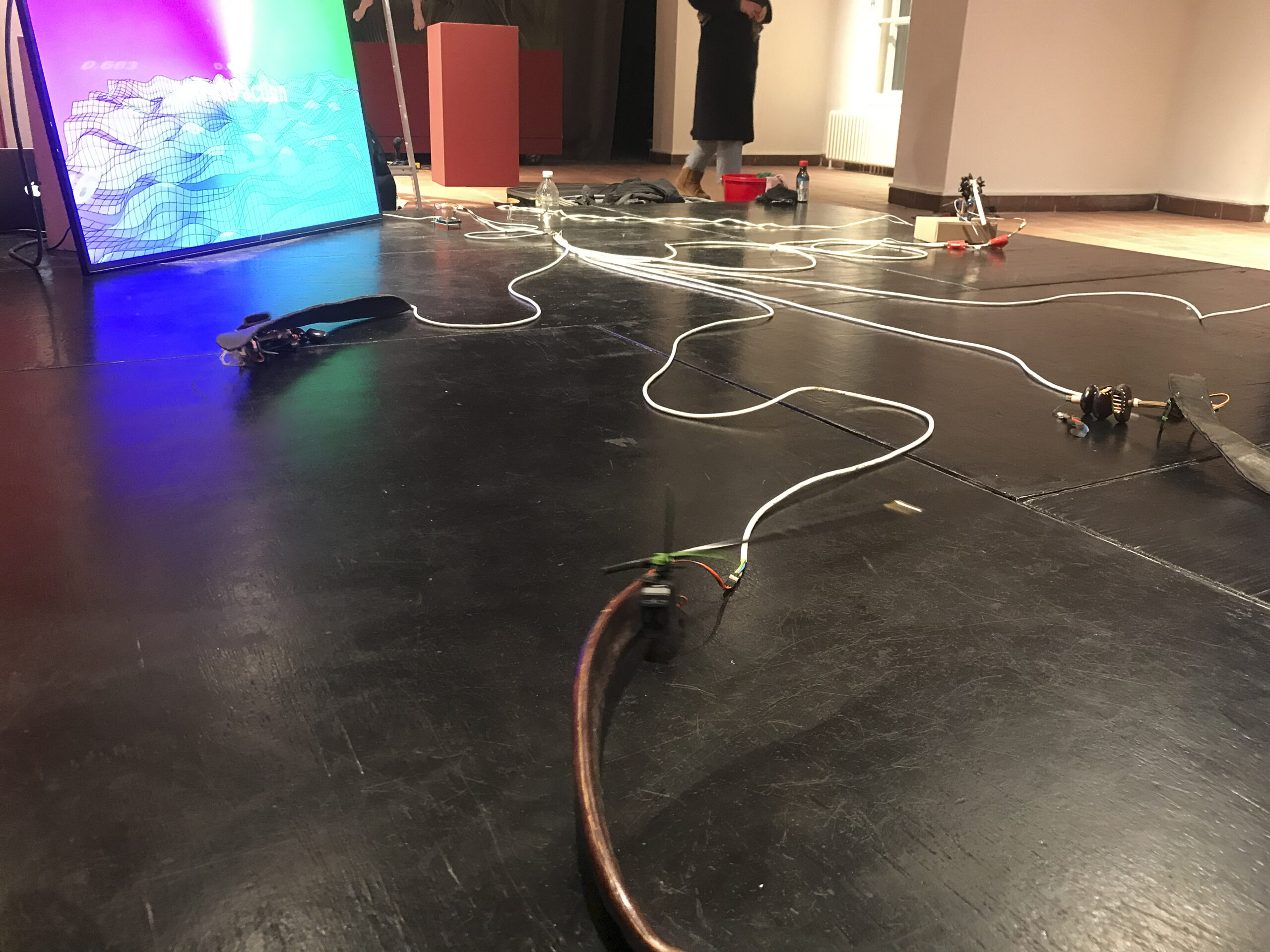Kinetic sound and video installation, 7 mini robots, sound
“The sound objects represent for me the place between objectivity (of a seed) and the longing for the unknown (the mystical through the ritual). Although I grew up in South America and had some mystical experiences, everything remains unknown and far away. With my migration to Germany, the memories were trivialized on the one hand, and on the other hand, another perspective emerged, which I can only attribute to simulation.”
Luis Negrón van Grieken on Ruido Perla











A monitor displays a 3D geometry that refers to the crossing of a mountainous landscape.
On the floor is a series of seedpods from a flame-tree and a set of rattles from the Amazon, connected to the same data source of the synthesized landscape, forming a kinetic sculpture.
The pods and rattles function as sound objects that follow an apparently non-intentional musical composition.
The choreography of the sound objects and the video are generated by the use of the Perlin algorithm (developed for the generation of natural phenomena in the 1982 film Tron by Kevin Perlin). In this way, a gesture of the precise of the programmatic and the organic is united in the chaotic nature of a landscape.
The choreography originates from a mathematical model (the Perlin Noise) for the generation of digital landscapes. In this way, the method often used for video games to synthesize the digital mountains is combined with the acoustics common to shamans and shamanines in South America during communal rituals.
Repeatedly, the contemplation is interrupted by a loudspeaker voice, opening up another level through language. Literally the machine begins to speak. The installation floats in the spirit of the bachelor machines (1), which also demonstrate two facets; one mechanical and the other invisible beyond any specific function.
German
Auf einem Monitor wird eine 3D-Geometrie angezeigt, die auf die Durchquerung einer Gebirgslandschaft anspielt.
Auf dem Boden befindet sich eine Reihe von Schoten eines Flammenbaums und Rasseln aus dem Amazonasgebiet, die mit derselben Datenquelle der synthetisierten Landschaft verbunden sind und eine kinetische Skulptur bilden. Die Schoten und Rasseln fungieren als Klangobjekte, die einer offensichtlich nicht-intentionalen Musikkomposition folgen.
„Die Klangobjekte repräsentieren für mich den Ort zwischen Objektivität (eines Samens) und der Sehnsucht nach dem Unbekannten (dem Mystischen durch das Ritual). Obwohl ich in Südamerika aufgewachsen bin und einige mystische Erfahrungen gemacht habe, bleibt alles unbekannt und weit weg. Mit meiner Migration nach Deutschland wurden die Erinnerungen einerseits trivialisiert, andererseits entstand eine andere Perspektive, die ich nur auf Simulation zurückführen kann.“
Luis Negrón van Grieken
Die Choreographie der Klangobjekte und Erzeugung des Videos sind durch die Verwendung des Perlin-Algorithmus (entwickelt für die Erzeugung von Naturphänomenen in dem Film Tron von Kevin Perlin aus dem Jahr 1982) erzeugt. Auf dieser Weise wird eine Geste des Präzisen des Programmatischen und des Organischen in der chaotischen Natur einer Landschaft vereint.
Die Bewegungs-Choreographie entspringt einem mathematischen Modell (Perlin Noise) zur Erzeugung von digitalen Landschaften. So wird die für Videospiele oft eingesetzte Methode, zur Synthese verbunden, der Synthese der digitalen Gebirgslandschaft mit der für Schamanen und Schamaninnen in Südamerika üblichen Akustik bei gemeinschaftlichen Ritualen.
Immer wieder wird die Kontemplation durch eine Lautsprecher-Stimme unterbrochen, und eröffnet damit eine weitere Ebene durch die Sprache. Die Maschinen beginnen buchstäblich zu sprechen.
Die Installation schwebt im Geiste der Junggesellenmaschinen, die ebenso Zwei Facetten zeigen; die eine mechanische und die andere unsichtbare jenseits jeder spezifischen Funktion.
